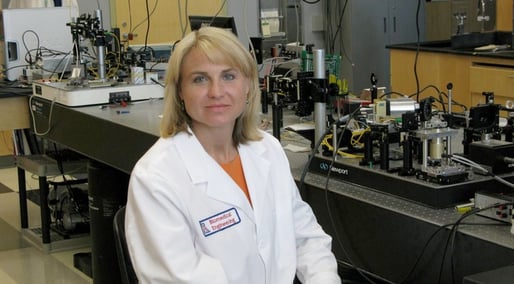 (Dr. Barton, researcher at the University of Arizona. Photo courtesy of U of A)
(Dr. Barton, researcher at the University of Arizona. Photo courtesy of U of A)
The National Cancer Institute is funding a million dollar study at the University of Arizona to help detect ovarian cancer sooner. It is hoped this project will lead to the first effective screening test for a disease that kills 14,000 women a year and often gives little to no warning of its presence until it’s too late.
How is ovarian cancer different than other cancers?
In many ways it’s not. According to the American Cancer Society, “Cancer starts when cells in the body begin to grow out of control. Cells in nearly any part of the body can become cancer, and can spread to other areas of the body... Ovarian cancer begins in the ovaries.”
The difference is its mortality rate. Though, ovarian cancer only accounts for about 3% of cancers among women, it causes more deaths than any other cancer of the female reproductive system. In fact, women have about a 1 in 100 lifetime chance of dying from ovarian cancer. It is usually diagnosed in women over 63, and fewer than half those diagnosed survive past five years.
Why is the mortality rate so high?
Because as with any cancer early detection is key to successful treatment and ovarian cancer is very hard to detect. Only about 20% of ovarian cancers are found at an early stage. The affected area is deep within the body, so symptoms are often vague and are common to many other conditions.
These symptoms include:
- Bloating
- Pelvic or abdominal pain
- Trouble eating or feeling full quickly
- Urinary symptoms such as urgency (always feeling like you have to go) or frequency (having to go often)
There is currently no effective way to screen for ovarian cancer. Pap smear tests are effective for cervical cancer, but do not detect ovarian cancer unless it has spread and is at an advanced stage. While pelvic exams are useful for finding some reproductive system cancers at an early stage, most early ovarian tumors are difficult for even the most skilled examiner to feel. Imaging tests such as CT and MRI as well at ultrasounds can confirm the presence of pelvic mass but cannot confirm that the mass is cancer. Currently, the only way to diagnose ovarian cancer is to do a biopsy.
So early detection could be a real game changer?
Yes. When caught early, ovarian cancer can often be successfully treated with surgery and chemotherapy. However, according to the UA News website, currently “70% of women diagnosed have advanced ovarian cancer that has spread beyond the Fallopian tubes and ovaries to other organs.” Dr. Jennifer Barton, University of Arizona researcher and interim director of UA’s BIO5 Institute, is trying to change that. Her project is working to identify the biomarkers and create the optical imaging tools to make screening for this silent killer possible.
How will Dr. Barton’s Researcher Achieve This?
Dr. Barton is collaborating with U of A researchers from several different departments to identify biomarkers, subtle changes in tissues, that can be detected by sensitive, high-resolution optical imaging techniques. Her study utilizes mice because they spontaneously develop ovarian tumors and give researchers a controlled way of studying cancer. Dr. Barton says, “We can observe developments over just a few months that would occur over several years in women with the disease.” Researchers are using these images to create a map of the changes that happen in the ovaries and Fallopian tubes during ovarian cancer so they can “build a viable optical imaging technology that will enable early detection and save lives.”
About Research at University of Arizona
University of Arizona, Tucson is the state’s leading research university with  nearly $300 million in research and development expenditures annually. Biotechnology Calendar Inc. will be hosting the 14th Annual BioResearch Product Faire at the University of Arizona, Tuscon this November. This event provides science professionals the opportunity to meet face to face with laboratory equipment suppliers.
nearly $300 million in research and development expenditures annually. Biotechnology Calendar Inc. will be hosting the 14th Annual BioResearch Product Faire at the University of Arizona, Tuscon this November. This event provides science professionals the opportunity to meet face to face with laboratory equipment suppliers.
To learn more about participating in this premiere life science marketing event, visit the link below:
Science professionals attend for free. Save time at the door by preregistering.



